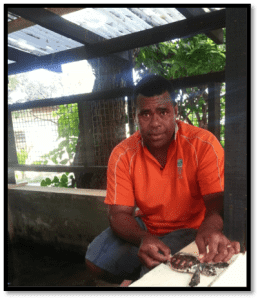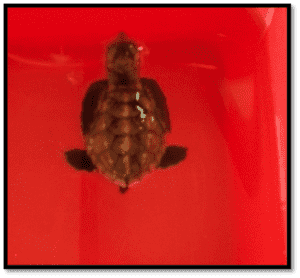A baby turtle was found crawling ashore at the South Beach of Mana Island on April 1st much to the delights of the staff.
For many years, there was no nesting at the Magical Man Island and the drifter was called Ratu Mana.
Probably tired from years of drifting passively around the Mana Lagoon, fighting waves and predators, the tiny hatchling finally gave up on the popular South Beach.
Jimilai Bete who was on duty saw the baby turtle crawling ashore and took it to the rearing pond.
Activities Manager, Deborah Manulevu said ‘The turtle hatchling was very inactive during its first hours in their captive pond. After three days the hatchling started feeding and moved around actively and is in the care of the Marine Activities staff. The hatchling is feeding well on seagrass and halimeda which is calcerous gree algae,” she said.
Ratu Mana is a Hawkbill turtle belonging to the Eretmochelys imbricate species.
Mamanuca Environment Society Assistant Manager, Mrs Marica Vakacola was on the island did all measurement for the turtle.
The turtle has a shell width of 4.2cm and a length 5.7cm. All measurement recorded was entered in the Turtle Research and Monitory Database Tool (TRED) which is monitored by South Pacific Region Environment Programme(SPREP) of which Mamanuca Environment Society is a member of.
According to SPREP Turtle Monitoring Representative, Catherine Siota, ‘The data for the new hatchling will be considered as a unique encounter.
It is the first turtle recorded in the TRED for the Mamanuca group this year and Mana Environment Team is happy to keep Ratu Mana in their captive breeding pond together with seven other Hawksbill turtle.
Three out of the seven hawksbill turtle are ready for release to the environment.
“Hawksbill turtle is an endangered species in Fiji and keeping them in captive breeding pond allows more chances of survival. The main danger for hatchlings is from artificial lighting. When the babies emerge, they instinctively move in the brightest direction.
“Normally, this would be the open night sky reflected by the ocean. On a developed beach, artificial lights attract the hatchlings, causing them to crawl in the wrong direction. Other dangers include obstructions on the beach, such as beach chairs, holes, or tire tracks, all of which can block their path to the sea,” said Mrs Vakacola.




